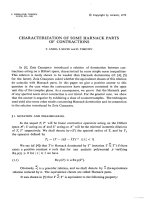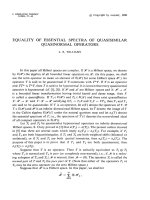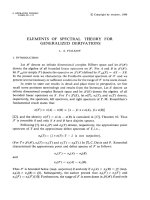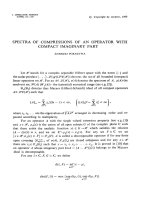Báo cáo toán học: "Relaxations of Ore’s condition on cycles" potx
Bạn đang xem bản rút gọn của tài liệu. Xem và tải ngay bản đầy đủ của tài liệu tại đây (118.71 KB, 9 trang )
Relaxations of Ore’s condition on cycles
Ahmed Ainouche
CEREGMIA-GRIMAAG
UAG-Campus de Schoelcher
B.P. 7209
97275 Schoelcher Cedex
Martinique (FRANCE)
Submitted: Jun 14, 2004; Accepted: Jun 14, 2006; Published: Jul 28, 2006
Abstract
A simple, undirected 2-connected graph G of order n belongs to class O(n,ϕ),
ϕ ≥ 0, if σ
2
= n − ϕ. It is well known (Ore’s theorem) t hat G is hamiltonian if
ϕ = 0, in w hich case the 2-connectedness hypothesis is implied. In this paper we
provide a method for studying this class of graphs. As an application we give a full
characterization of g raphs G in O(n,ϕ),ϕ≤ 3, in terms of their dual hamiltonian
closure.
Keywords: Hamiltonian Cycle, Dual Closure.
1 Introduction
We consider throughout only simple 2-connected graphs G =(V,E). We let α(G),ν(G),
ω(G) denote respectively the independence number, the matching number and the number
of components of the graph G. A graph G is 1-tough if |S|≥ω(G−S) is true for any subset
S ⊂ V with ω(G − S) > 1. For k ≤ α(G)wesetσ
k
=min
x∈S
d(x) | S is a stable set
.
We use the term stable to mean independent set. A graph G of order n belongs to class
O(n, ϕ),ϕ≥ 0ifσ
2
= n −ϕ. It is well known ([13]) that G is hamiltonian if G ∈O(n, 0),
in which case the 2-connectedness hypothesis is implied. Jung ([8]) proved that a 1-tough
graph G ∈O(n ≥ 11, 4) is hamiltonian. Indeed this is a strong assumption which is not
easy to verify since recognizing tough graphs is NP-Hard ([10]). Ignoring the hypothesis of
1-toughness but conserving the constraint on n,thatisn ≥ 3ϕ − 1, we obtained in ([4]) a
characterization of graphs in O(n, ϕ ≤ 4). Without any constraint on n, a characterization
of graphs in O(n, ϕ ≤ 2) is given in ([2] and [9]). The same characterization was given by
Schiermeyer ([12]) in terms of the dual-closure of G.
the electronic journal of combinatorics 13 (2006), #R60 1
In this paper we go a step further than Shiermeyer by giving a complete map of graphs
in O(n, ϕ ≤ 3) with respect to the hamiltonian property. The dual closure ([1, 2, 5]) of
those graphs is completely determined. This is indeed useful since then finding a cycle in
G of maximum length becomes a polynomial problem.
2 Preliminary results
A vertex of degree n − 1 is a dominating vertex and Ω will denote the set of dominating
vertices. The circumference c(G)ofG is the length of its longest cycle. For u ∈ V (G),
let N
H
(u) denote the set and d
H
(u) the number of neighbors of u in H, a subgraph of
G.IfH = G we will write simply N(u) for N
G
(u)andd(u) for d
G
(u) respectively. For
convenience, we extend this notation as follows. Given a subset S ⊂ V , we define the
degree of a vertex x with respect to S as d
S
(x) to be the number of vertices of S adjacent
to x.ForX ⊂ V , put N(X)=∪
u∈X
N(u). If X, Y ⊂ V ,letE(X, Y )denotethesetof
edges joining vertices of X to vertices of Y. As we need very often to refer to a presence
or not of an edge, we write xy to mean that xy ∈ E and
xy to mean xy /∈ E For each
pair (a, b) of nonadjacent vertices we associate
G
ab
:= G − N(a) ∪ N(b),γ
ab
:= |N(a) ∪ N(b)| ,λ
ab
:= |N(a) ∩ N(b)|
T
ab
:= V \ (N [a] ∪ N [b]) ,t
ab
:= |T
ab
| , α
ab
:= 2 + t
ab
= |V (G
ab
)|
δ
ab
:= min {d(x) | x ∈ T
ab
} if T
ab
= ∅ and δ
ab
:= δ(G) otherwise
α
ab
= α(G
ab
),ν
ab
= ν(G
ab
),ω(T
ab
)=ω(G [T
ab
]).
In this paper there is a specially chosen pair (a, b) of vertices. To remain simple, we
omit the reference to a, b for all parameters defined above. Moreover we understand T
as the set, the graph induced by its vertices and its edge set. Our proofs are all based
on the concept of the hamiltonian closure ([11], [1], [2]). The two conditions of closure
developed in [1], [2] are both generalizations of Bondy-Chv`atal’s closure. To state the
condition under which our closure is based we define a binary variable ε
ab
associated with
(a, b).
Definition 2.1 Let ε
ab
∈{0, 1} be a binary variable, associated with a pair (a, b) of
nonadjacent vertices. We set ε
ab
=0if and only if
1. ∅ = T and all vertices of T have the same degree 1 + t. Moreover λ
ab
≤ 1if
N(T)\T ⊆ N(a) N(b), (where denotes the symmetric difference).
2. one of the following two local configurations holds
(a) T is a clique (possibly with one element), λ
ab
≤ 2 and there exist u, v /∈ T such
that T ⊂ N(u) ∩ N(v).
(b) T is an independent set (with at least two elements), λ
ab
≤ 1+t and either
N(T) ⊆ D or there exists a vertex u ∈ N(a) N(b) such that |N
T
(u)|≥
|T |−max (λ
ab
− 1, 0) . Moreover T is a clique in G
2
, the square of G.
the electronic journal of combinatorics 13 (2006), #R60 2
Lemma 2.2 (the main closure condition) Let G be a 2-connected graph and let (a, b)
be a pair of nonadjacent vertices satisfying the condition
α
ab
≤ max {λ
ab
+ ν
ab
,δ
ab
+ ε
ab
} (ncc)
Then c(G)=p if and only if c(G + ab)=p, p ≤ n.
The first condition is a relaxation of the condition α
ab
≤ max {λ
ab
, 2} given in [1].
Since by definition
α
ab
is the order of G
ab
, it follows that α
ab
≤ α
ab
. As α
ab
is not easy
to compute we developed many upper bounds of α
ab
, computable in polynomial time
([1], [6]) . One of these upper bounds is precisely ν
ab
. It is known that for any graph H,
α(H)+ν(H) ≤ n(H). We note that ν
ab
= ν (G
ab
)=ν (T )sincea, b are isolated vertices in
G
ab
, we see that α
ab
− ν
ab
≤ α
ab
and hence α
ab
≤ max {λ
ab
, 2} implies α
ab
≤ λ
ab
+ ν
ab
. We
note that
α
ab
≤ λ
ab
+ ν
ab
is stronger than Bondy-Chv`atal’s hamiltonian closure condition
([11]) since d(a)+d(b) ≥ n ⇔
α
ab
≤ λ
ab
. The second part of the condition (ncc) is a
relaxation of a strongest one given in [1], improved in ([5]) .The condition
α
ab
≤ δ
ab
+ ε
ab
,
especially with the addition of the term ε
ab
will prove to be a most useful tool in obtaining
the main properties of the dual closure of any graph G ∈O(n, 3). The condition
α
ab
≤
λ
ab
+ν
ab
is only used in very particular cases. Note that α
ab
≤ δ
ab
+ε
ab
⇔ γ
ab
+δ
ab
+ε
ab
≥ n
and
α
ab
≤ λ
ab
+ ν
ab
⇔ d(a)+d(b)+ν
ab
≥ n.
The 0-dual neighborhood closure nc
∗
0
(G) (the 0−dual closure for short) is the graph
obtained from G by successively joining (a, b) satisfying the condition (ncc)untilnosuch
pair remains. Throughout we denote nc
∗
0
(G)byH. All closures based on the above
conditions are well defined. Moreover, it is shown in ([6], [5]) that it takes a polynomial
time to construct H and to exhibit a longest cycle in G whenever a longest cycle is known
in H.
As a direct consequence of Lemma 2.2 we have.
Corollary 2.3 Let G be a 2-connected graph. Then G is hamiltonian if and only if H is
hamiltonian.
3 Results
To state our results, we define first three nonhamiltonian graphs (H
1
7
to H
3
7
)ontheset
{a, b, d, u, v, x, y} of 7 vertices. For all the three graphs, d is dominating and au, bv, ux
are edges. We refer to H as H
1
7
if vx, xy and uv. We refer to H as H
2
7
by removing uv
from H
1
7
. In H
3
7
, uv and vy are edges. These three graphs are all in O(7, 3) and only H
1
7
is
1-tough. Next we define a family K
ϕ
n
of nonhamiltonian graphs. A graph G of order n is
in K
ϕ
n
for ϕ ≥ 1ifitsdualclosureH satisfies the condition |Ω| +1≤ ω(H − Ω) ≤|Ω| + ϕ
and each component of H − Ω is any graph on maximum ϕ vertices.
Theorem 3.1 Let G ∈O(n, ϕ), 0 ≤ ϕ ≤ 3, and let H := nc
∗
0
(G). Then (i) G is hamil-
tonian if and only if either H = C
7
, in which case ϕ =3or H = K
n
and (ii) G is
nonhamiltonian if and only if either ϕ =3,n=7and H = H
i
7
,i=1, 2, 3 or H ∈K
ϕ
n
.
the electronic journal of combinatorics 13 (2006), #R60 3
Proof. Follows directely from Lemmas 5.1 to 5.5 in section 5.
Corollary 3.2 Let G ∈O(n, ϕ), 0 ≤ ϕ ≤ 3. If n ≥ 3ϕ − 1 then G is hamiltonian if and
only if H = K
n
and nonhamiltonian if and only if H ∈K
ϕ
n
.
Corollary 3.3 Let G ∈O(n, ϕ), 0 ≤ ϕ ≤ 3. Then H ∈{K
n
,C
7
,H
1
7
} if G is 1-tough.
Corollary 3.4 Let G ∈O(n, ϕ), 0 ≤ ϕ ≤ 3. If G is not hamiltonian then c(G)=c(H) ≥
n − ϕ. Moreover c(G)=c(H)=n − 1 if n ≥ 3(ϕ +1).
4 General Lemmas
In this section we assume G ∈O(n, ϕ),ϕ≥ 0 and all neighborhood sets and degrees are
understood under H, unless otherwise stated. With each pair (a, b) we adopt the following
decomposition of V by setting A := N(a)\N(b), A
+
:= A ∪{a} ,B := N(b)\N(a),B
+
:=
B∪{b} ,D:= N(a)∩N(b),T := T
ab
where t = |T | . Also we set T
i
:= {x ∈ T | d
T
(x)=i} ,
i ≥ 0. We point out that T = ∅ by (ncc) whenever H = K
n
since H is 2-connected.
For an ordered pair (x, y) of nonadjacent vertices we set N(x, y):=N(x)\N(y)and
n(x, y):=|N(x, y)| . With this notation, we have A = N(a, b)andB = N(b, a). We shall
say that H = K
n
is (a, b)-well-shaped if E(A ∪ B, T) ∪ E(A, B)=∅ and Ω = D.
Throughout, a, b are chosen as follows:
(i)
ab and d(a)+d(b)=σ
2
= n − ϕ,
(ii) subject to (i), λ
ab
is minimum.
(iii) subject to (i) and (ii) and if possible H is (a, b)-well-shaped.
Moreover we always assume d(a) ≤ d(b) ≤ d(x) for any x ∈ T. This choice implies
immediately.
Lemma 4.1 If H = K
n
and ϕ ≥ 1 then
(L1) 2 + t = λ
ab
+ ϕ.
(L2) ∀p, q ∈ V,
pq ⇒ max {n(p, q),n(q, p)} + ε
pq
<ϕ.
(L3) |A|≤|B| <ϕ− ε
ab
.
(L4) T = ∪
ϕ−1
j=0
T
j
. Furthermore either T
ϕ−1
= ∅ or E(A ∪ B,T) ∪ E(A, B)=∅.
(L5) if u ∈ A then d
A∪T
(u)+ε
bu
≤ ϕ − 2+d(a) − δ
bu
. Similarly if v ∈ B then d
B∪T
(v)+
ε
av
≤ ϕ − 2+d(b) − δ
av
.
(L6) if A ∪ B = ∅ then
xy = ∅ ⇒ d
T
(x)+d
T
(y)+ν
xy
<ϕfor all x, y ∈ T
the electronic journal of combinatorics 13 (2006), #R60 4
Proof. (L1). By choice of a, b we have d(a)+d(b)=n − ϕ. This is equivalent to
2+t = λ
ab
+ ϕ.
(L2) If
pq then γ
pq
+ δ
pq
+ ε
pq
<n.Let us choose r ∈ T
pq
such that d(r)=δ
pq
.
This vertex exists since T
pq
= ∅ by (ncc). Since clearly γ
pq
= d(q)+n(p, q), we have
n(p, q)+d(q)+d(r)+ε
pq
<n.By hypothesis d(q)+d(r) ≥ n − ϕ since qr. It follows that
(L2) holds. In particular if
pq and n(p, q)=ϕ − 1thenε
pq
=0.
(L3) This is a consequence of (L2) since B = N(b, a).
(L4) Clearly T = ∪
t−1
j=0
T
j
. If T
j
= ∅ for j ≥ ϕ then n(x, a)=|N
T
(x)|≥ϕ, a
contradiction to (L2). Suppose next vy for some (v, y) ∈ B × T and choose z ∈ T
ϕ−1
.
Clearly z = y for otherwise n(y, a) ≥ ϕ, acontradictionto(L2). By (L2) ,ε
az
=0and
hence T
az
must be a clique since bv ∈ T
az
. But then by since vy. Thus E(B, T)=∅.
Similarly E(A, T )=∅. Next suppose vu for some (v, u) ∈ B × A. Again T
az
is a clique
and vu ⇒ bu. Therefore E(A, B)=∅.
(L5) Because
ub, u ∈ A and by (ncc)wehaveα
ub
>δ
ub
+ ε
ub
. Obviously α
ub
=
1+|A|−d
A
(u)+t − d
T
(u)=1+d(a) − λ
ab
− d
A
(u)+t − d
T
(u). By (L1) we get
α
ub
=1+d(a)+ϕ − 2 − (d
A
(u)+d
T
(u)) . On the other hand δ
ub
≥ d(b) ≥ d(a).From
these inequalities we obtain d
A
(u)+d
T
(u)+ε
ub
≤ ϕ − 2. Similarly d
A
(u)+d
T
(u)+ε
ub
≤
ϕ − 2.
(L6) We observe that d(x)+d(y)=2λ
ab
+ d
T
(x)+d
T
(y). Then 2λ
ab
+ d
T
(x)+d
T
(y)+
ν
ab
<nby (ncc) . On the other hand n = d(a)+d(b)+ϕ =2λ
ab
+ ϕ. Statement (L6)
follows easily.
5 Application to graphs in O(n, ϕ),ϕ≤ 3
Throughout, we assume H := nc
∗
0
(G) = K
n
.
Lemma 5.1 If G ∈O(n, 1) then H ∈K
1
n
.
Proof. By hypothesis, d(a)+d(b) ≥ n − 1orequivalently
α
ab
≤ λ
ab
+1. By (ncc)
α
ab
> max {λ
ab
+ ν
ab
,δ
ab
+ ε
ab
} since ab. It follows that ν
ab
= ε
ab
=0. Moreover T is
independent and d(x)=δ
ab
= λ
ab
= d(a)=d(b) holds for any x ∈ T. This means in
particular that A ∪ B = ∅.and N
D
(v)=D is true for each vertex v ∈ V \D. Furthermore
D must be a clique for if
ef for some (e, f) ∈ D
2
then α
ef
≤|D| = λ
ab
≤ λ
ef
= |V \D| ,
acontradictionto(ncc). Therefore Ω = D and ω(H − Ω) = |V \D| . Clearly | D| =
n−1
2
and |V \D| =
n+1
2
since d(a)+d(b)=n − 1=2λ
ab
. It follows that ω(H − Ω) =
n+1
2
and
H ∈K
1
n
.
Lemma 5.2 If G ∈O(n, 2) then H ∈K
2
n
.
Proof. Now ν
ab
≤ 1. As a first step, we prove that N
D
(v)=D is true for each vertex
v ∈ V \D. Choose (x, e) ∈ T × D. If
ex then n(e, x) ≥|{a, b}| =2, a contradiction to
(L2) . Moreover E(A ∪ B,T)=∅ for if there exists an edge ux with (u, x) ∈ A × T then
the electronic journal of combinatorics 13 (2006), #R60 5
n(u, b) ≥ 2, acontradictionto(L2) . Similarly E(A, B)=∅ for if there exists uv for some
(u, v) ∈ A × B then n(u, x) ≥ 2. It follows that N
D
(u)=D is also true for each vertex
u ∈ A∪B since by the choice of a, b, d(u) ≥ d(a)ifu ∈ A and d(u) ≥ d(b)ifu ∈ B. As for
the proof of the above Lemma we get Ω = D. If ν
ab
= 0 then clearly H =(m +2)K
1
+K
m
with m = λ
ab
. If ν
ab
=1andt =2then(K
r
∪ K
s
∪ K
2
)+K
2
, 1 ≤ r ≤ s ≤ 2. If ν
ab
=1
and t>2then((m +1)K
1
∪ K
2
)+K
m
with m ≥ 3. In all cases, one can easily check
that ch that H ∈K
2
n
.
Lemma 5.3 If G ∈O(n, 3) and λ
ab
=0then H = C
7
.
Proof. By (L1) we obtain t =1. Assuming T = {x},wegetd(x)=2by(ncc) . It
follows that d(a)=d(b) = 2 by the choice of a, b. As d(a)+d(b)=4=n − 3, we have
n =7. Set N(a)={a
1
,a
2
} and N(b)={b
1
,b
2
} . If N(x)=B then T
ab
2
= {b
1
} and
hence d(b
1
)=2by(ncc) . But now H − b
2
is disconnected. With this contradiction, we
deduce that N(x) = B. Similarly N(x) = A. Assume then xa
1
and xb
1
.NowT
ab
1
= {b
2
}
and hence d(b
2
)=2by(ncc) . Similarly d(a
2
)=2. As H is 2-connected, we must have
N
B
(a
2
) = ∅ and N
A
(b
2
) = ∅. Suppose first a
2
b
1
and a
1
b
2
. This would contradict (ncc)
since T
a
1
b
1
= ∅. It remains to admit that a
2
b
2
, in which case H = C
7
, as claimed.
Lemma 5.4 If G ∈O(n, 3) and λ
ab
=1then H = H
i
7
,i=1, 2, 3.
Proof. By (L1) ,t= 2 and we may assume T := {x, y} ,d(y) ≤ d(x)andD := {d}.
Moreover T ⊆ T
0
∪ T
1
.
Claim 1. ε
ab
=1
By contradiction, suppose ε
ab
=0. Then d(x)=d(y)=3,T is either a clique or a
stable and d(a) ≤ d(b) ≤ 3. If xy then by Definition 2.1(2.a), there exist r, s ∈ N(a)∪N(b)
and N(r) ∩ N(s) ⊃{x, y} . Assuming r = d then r ∈ A ∪ B. It follows that d
T
(r)=2,a
contradiction to (L5). Suppose next
xy. In one hand we obviously have |N
A∪B
(x)|≥2,
|N
A∪B
(y)|≥2and|N
A∪B
(x) ∩ N
A∪B
(y)|≤1by(L5) . As |A ∪ B|≤2, we deduce that
|N
A∪B
(x)| = |N
A∪B
(y)| =2, |A| = |B| =2andN(d) ⊃{x, y} . Set A = {u, u
} and
B = {v, v
} . Only two configurations are possible : N
A∪B
(x)={u, v} ,N
A∪B
(y)={u
,v
}
or N
B
(x)=B, N
A
(y)=A. For the first case T
av
= {y, v
} and ε
av
=0by(L2) since
n(v, a)=2=ϕ − 1. Since T
av
is a clique and |N(T
av
)\T
av
|≥3, we get a contradiction
to the definition of ε
av
. For the second case we may assume uv since H is 2-connected.
We note that u
v for otherwise n(v, u
)=3sinceu
u by (L5) . Now T
av
= {y, v} and
d(v) ≥ 4. By (ncc), av and we get the required contradiction for the proof of Claim 1. As
a consequence of this claim, we must have d(y)=2. This in turn implies A = {u} and
B = {v} .
Claim 2. H = H
i
7
,i=1, 2, 3
By the choice of a, b, d(y)=d(a)=d(b)=2⇒ N(y)∩{u, d}= ∅ and N(y)∩{v, d}=
∅. We claim that yd for otherwise N(y)={u, v} and N(x)={d} since N(x) ∩ N(y) ∩
{u, v} = ∅ by (L5) . This is obviously a contradiction. Next we show that dx. If d(x)=2,
the electronic journal of combinatorics 13 (2006), #R60 6
this is true by symmetry with y. Otherwise N(x)={y,u,v} and hence dx since T
dx
= ∅.
Moreover ud and vd, that is d ∈ Ω. To see this, suppose
ud for instance. Then T
ud
= {v}
and hence d(v)=2. But now we have λ
av
= 0 and choosing (a, v) instead of (a, b)weget
a contradiction. Let us consider two cases.
Case 1: xy.
Set F := {ux, ux, vx} . Since H − d must be connected, H must contain at least two
edges of F.IfH contains all edges of F then H = H
1
7
. This graph is 1-tough (in fact it is
the smallest 1-tough, non-hamiltonian graph). If H contains 2 edges of F then H = H
2
7
(we have three isomorphic graphs).
Case 2:
xy.
Since H − d must be connected, we must have uv. Since N(x) ∩ N(y) {u, v} = ∅, we
may assume ux and vy. We have now the third nonhamiltonian graph H = H
3
7
and the
proof is complete
Lemma 5.5 If G ∈O(n, 3) and λ
ab
≥ 2 then H ∈K
3
n
.
Proof. By (L2), t ≥ 3 and we recall that ν
ab
≤ 2. The proof is split into three claims.
Claim 1: E(A ∪ B,T) ∪ E(A, B)=∅.
By contradiction suppose first A ∪ B = ∅ and E(A ∪ B, T) = ∅. If ε
ab
=0thenby
Definition 2.1 (2.b), d
T
(v) ≥ t − λ
ab
+1. By (L1), d
T
(v) ≥ ϕ − 1 ≥ 2, a contradiction to
(L5) . With this contradiction, we assume ε
ab
=1, in which case B = {v} and A ⊆{u}
by (L3). Without loss of generality, assume vx for some (v, x) ∈ B × T. Consider now
T
av
= A
+
∪ (T
ab
\{x}) . As n(v, a)=2,we deduce that ε
av
=0by(L2) and consequently
T
av
is either a clique or a stable. Clearly T
av
cannot be a clique and hence it is a stable and
in particular A = ∅. Moreover d(a)=d(w) for any vertex of T
ab
\{x} , a contradiction to
the choice of a, b since now δ
ab
= d(a) <d(b). We have just proved that E(A ∪B,T)=∅.
Next suppose uv, (u, v) ∈ A × B. By (L4), T = T
0
∪ T
1
. Furthermore T
0
= ∅ for if
x ∈ T
0
then N(x) ⊆ D and hence d(x) <d(b). Therefore T = pK
2
with p ≥ 2since
t = λ
ab
+ ϕ − 2 ≥ 3. As N(u, x)={a, v} we have ε
ux
= 0 for any x ∈ T. This is a
contradiction since T
ux
is neither a clique nor a stable since it contains at least one edge
and the single vertex b.
Claim 2: H is (a, b)-well-shaped.
By Claim 1, it suffices to prove that Ω = D. We first note, by (ncc) , that Ω = D if
N
V \D
(e)=V \D holds for any e ∈ D. Choose (e, x) ∈ D × T such that ex. If A ∪ B = ∅
then B = {v} and N
D
(v)=D since d(v) ≥ d(b) by the choice of a, b. Therefore N(e, x) ⊇
{a, b, v} , acontradictionto(L2). For the remaining we assume A∪B = ∅. Clearly T
0
= ∅
since obviously x/∈ T
0
for if there exists y ∈ T
0
then necessarily xy and N
D
(y)=D and
hence n(e, y) ≥ 3, acontradictionto(L2). Therefore T = T
1
∪T
2
. Suppose first x ∈ T
2
. As
n(x, a)=2thenε
ax
= 0 and hence d(z)=d(b) for any vertex z ∈ T
ax
∩ T. By the choice
of (a, b)wemusthaveλ
az
= λ
ab
. So if z ∈ T
ax
∩ T then z ∈ T
0
.SinceT
0
= ∅ we conclude
that T
ax
= {b}. It follows that d(b)=2andt = ϕ =3by(L1). Therefore N [x]=T and
the electronic journal of combinatorics 13 (2006), #R60 7
T
ex
⊆{f },whereD = {e, f}.By(ncc), we have d(f)=2. This is a contradiction since
H − e cannot be disconnected. Finally suppose T = T
1
.Nowd(x)=d(b)sinceex, while
λ
ax
<λ
ab
, a contradiction. The proof of Claim 2 is now complete.
Claim 3: H ∈K
3
n
.
We set m = λ
ab
and we recall that Ω = D, E(A ∪ B,T)=E(A, B)=∅. By (L4),
T ⊆ T
0
∪ T
1
∪ T
2
.
Case 1: A ∪ B = ∅ and T
2
= ∅.
In this case we necessarily have T = T
1
∪ T
2
. Choose a vertex z ∈ T
2
. By (L2) , applied
to (a, z)and(b, z)wegetε
az
= ε
bz
=0. It follows that, for instance T
az
⊃ B
+
must be
either a clique or a stable.
If T
az
is a clique then necessarily T
az
= B
+
and hence t =3andλ
ab
=2by(L1). It
is not diffficult to check that H =(K
r
∪ K
s
∪ M
3
)+K
2
, 1 ≤ r ≤ s ≤ 3wherer = |A
+
| ,
s = |B
+
| and M
3
∈{P
3
,K
3
} . If s =3thenM
3
= K
3
by the choice of a, b. For this sub-case
we have H ∈K
3
n
, as claimed.
Case 2: A ∪ B = ∅ and T
2
= ∅.
In this case we necessarily have T = T
1
. Set T = pK
2
. Thus ν
ab
= p and by (ncc),
2t = s<3 for otherwise ab. It follows that t =4sincet is even and greater than 3.
Therefore H =(K
r
∪ K
s
∪ 2K
2
)+K
3
, 1 ≤ r ≤ s ≤ 2, ie H ∈K
3
n
.
Case 3: A ∪ B = ∅.
By (L6) we have
xy = ∅ ⇒ d
T
(x)+d
T
(y)+ν
xy
≤ 2(∗). By (L4) ,T= T
2
∪ T
1
∪ T
0
.
Suppose first T
2
= ∅ and let z ∈ T
2
. By (∗), we necessarily have T = N [z] ∪ T
0
, that
is T = M
3
∪ (m − 2) K
1
where M
3
∈{P
3
,K
3
} (recall that t = λ
ab
+1=m +1). Thus
H =(mK
1
∪ M
3
)+K
m
,m≥ 3, that is H ∈K
3
n
.
Next suppose T
2
= ∅ but T
1
= ∅. Set T = pK
2
∪ qK
1
. Clearly p ≤ 2by(∗). If p =2
and T
0
= ∅ then H =(K
r
∪ K
s
∪ 2K
2
)+K
3
,r= s =1. If p =2andT
0
= ∅ then
H =((m − 1)K
1
∪ 2K
2
)+K
m
,m≥ 4. If p =1andT
0
= ∅ then we have ϕ =2.Finally,
if p =1andT
0
= ∅ then H =((m +2)K
1
∪ K
2
)+K
m
,m≥ 3.
Finally, suppose T = T
0
. In this case H =(2+t)K
1
+ K
m
, m = λ
ab
≥ 2. By (L1),
2+t = m +3. Therefore H =(m +3)K
1
+ K
m
. In all cases H ∈K
3
n
.
References
[1] A. Ainouche, N. Christofides: Strong sufficient conditions for the existence of hamil-
tonian circuits in undirected graphs, J. Comb. Theory (Series B) 31 (1981) 339–343.
[2] Ainouche, A. and Christofides, N.: Conditions for the existence of Hamiltonian Cir-
cuits based on vertex degrees. J. London Mathematical Society (2) 32 (1985) 385–
391.
[3] A. Ainouche, N. Christofides: Semi-independence number of a graph and the exis-
tence of hamiltonian circuits Discrete Applied Mathematics 17 (1987) 213–221.
the electronic journal of combinatorics 13 (2006), #R60 8
[4] A. Ainouche: Extension of Ore’s Theorem, Maghreb Math. Rev., Vol 2, N
◦
2, 1992,
1–29.
[5] A. Ainouche: Extensions of a closure condition: the β−closure. Working paper,
CEREGMIA, 2001.
[6] A. Ainouche: Extensions of a closure condition: the α−closure. Working paper,
CEREGMIA-GRIMAAG, 2002.
[7] A. Ainouche and I. Schiermeyer: 0-dual closure for several classes of graphs. Graphs
and Combinatorics 19, N
◦
3 (2003), 297–307.
[8] H. A. Jung: On maximal circuits in finite graphs, Annals of Discrete Math. 3 (1978)
129–144.
[9] E. Schmeichel and D. Hayes: Some extensions of Ore’s theorem, in Y. Alavi, et al.,
ed., Graph Theory and applications to Computer Science (Wiley, New York, 1985),
687–695.
[10] D. Bauer, S.L. Hakimi, E. Schmeichel: Recognizing tough graphs is NP-HARD.
Discrete Applied Mathematics 28 (1990) 191–195.
[11] J.A. Bondy and V. Chv`atal: A method in graph theory, Discrete Math. 15 (1976)
111–135.
[12] I. Schiermeyer: Computation of the 0-dual closure for hamiltonian graphs.Discrete
Math. 111 (1993), 455–464 .
[13] O. Ore: Note on Hamiltonian circuits. Am. Math. Monthly 67, (1960) 55.
the electronic journal of combinatorics 13 (2006), #R60 9









